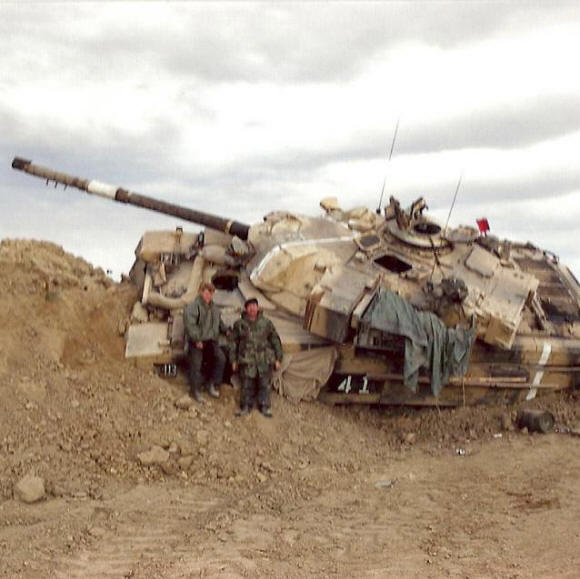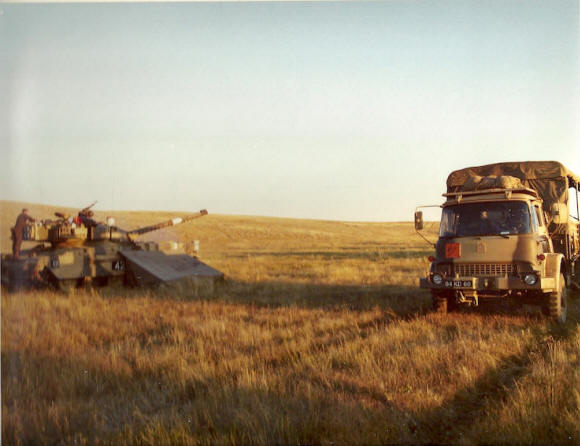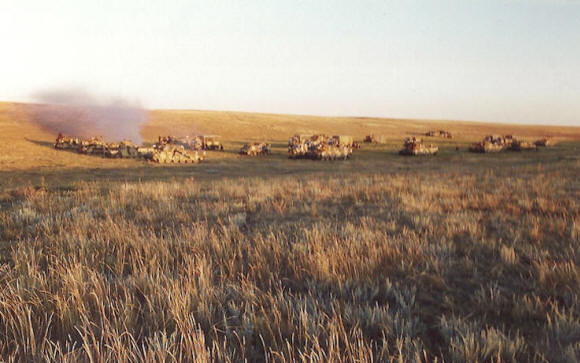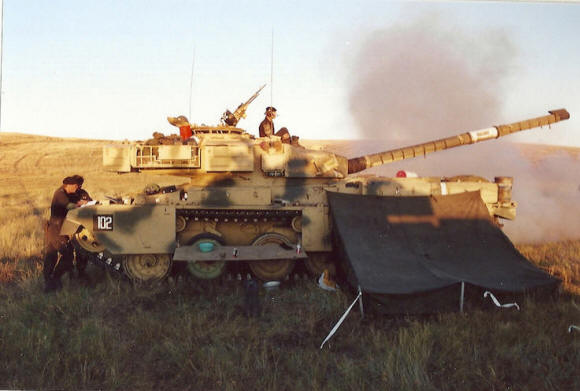|

HAVING
HEAVED a collective sigh of relief in waving goodbye to
Cyprus, it didn’t take long to get back into the groove
of being an armoured regiment on tanks again. The rear
party we had left behind whilst we were away had kept
the panzers in pretty good nick in our absence and it
wasn’t long before were back in the swing of things once
more.
We were faced with a full training season; tactical
training at the Soltau training area (SLTA), live firing
at Hohne Ranges, and then the ultimate confirmation of
“fitness for role” at the British Army Training Unit,
Suffield (BATUS) in Alberta, Canada. But before all of
that we had to go through all the low level training to
get us back in tank mode after our six month “holiday”
in Cyprus, and there seemed to be mountains of paperwork
in the Sqn office every day.
I had decided that I was a bit too old and stuffy to
live with the younger bachelor officers in the Mess
anymore, so managed to swing moving to an empty Married
Quarter (MQ) nearby, sharing with Richard Chesterfield,
who was also old and stuffy but not quite to the same
extent as me. It was a relief not to be the senior
living in officer anymore, and I’m sure it was a relief
for the subbies that I had moved out too!
I remember little of annual firing at Hohne but it would
have gone the way of all firing periods previously –
individual tanks firing, then firing by troop, then
firing on the move by troop, the latter called battle
runs. One innovation that we did introduce, though, was
the idea of firing and manoeuvring by half squadrons of
seven tanks, one half commanded by me and the other by
my 2ic Patrick Kidd. This was an attempt at the tactical
level to bring more mass and firepower to the point of
action than previously, and we continued the experiment
throughout the year.
Then we went back to the familiar old Soltau Training
Area for dry tactical training. That’s dry as in no live
ammunition, not as in alcohol free! The usual format
ensued – troop training, squadron training, then 4RTR
battlegroup (BG) training, for which we were joined by a
couple of companies of the Royal Greenjackets, or “the
Jaikets” as we called them. They were a pretty good
outfit.
Soltau culminated with the Brigade Commander’s test
exercise which was a corker. The exact details of the
activity escape me now, but I can remember being more
exhausted at the end than at any other time in my army
career, including Sandhurst. The exercise ended, as they
always did, with the counterattack at dawn against the
“enemy”, but I was so concerned that my tank crews would
be so tired they wouldn’t be awake when it was time to
launch that I spent the entire night going from panzer
to panzer making sure there was at least one crew member
awake. I need not have worried, perhaps, because at dark
o’clock in the morning I gave the order and they were
all rolling straight away.

Then we
went to Canada, flying Crab Air (RAF) via Keflavik in
Iceland, which I discovered was a NATO base at the time.
I have described the British Army Training Unit Suffield
(BATUS) in a previous episode, when I first went as a
troop leader, so I won’t reiterate the description again
here. Suffice to say it was still the dusty and slightly
scruffy camp in the middle of nowhere in Alberta.
However, this time around, perhaps I was older and a bit
more mature, I took better note of our surroundings.

The
Canadian prairie is, somewhat paradoxically, both bleak
and beautiful. The initial impression of neverending
flatness and loneliness is soon replaced by delight at
the fascinating folds and rises of the land; far from
being flat, the prairie is crossed by numerous
riverbeds, called coulees, and broken by hills and
escarpments which hide undiscovered valleys and plains.
Most of it is wild grassland which supports a wide array
of wildlife from occasional herds of wild mustangs down
to a multitude of colonies of gophers, some of which are
half tame after being fed by visiting troops over the
years. There is also evidence of man’s previous
occupation in the form of stone rings marking where the
indigenous people pitched their tepees, usually to be
found in the more sheltered sites or near the rivers.

We spent
almost exactly a month in Canada, including seventeen
days continuously out on the prairie living off our
tanks (photos above). During this time we were almost
oblivious to the deepening crisis in the Middle East
following Saddam Hussein’s occupation of Kuwait,
although we knew that plans were afoot back in the UK
and Germany. The training was hot, hard, and sometimes
mind-numbingly exhausting, but on other occasions quite
overwhelmingly exhilarating. At the end we felt we had
acquitted ourselves well and were “fit for role”.
On the second day of our return to the relatively
civilised environment of Camp Crowfoot, a collection of
prefabricated huts on the edge of the training area, the
news reached us that 7th Armoured Brigade (7 Armd Bde)
was being deployed to the Gulf. This was met with
disappointment by some and relief by others; had 12 Armd
Bde, which we were part of, been chosen, we ourselves
would have been on our way.
The consensus amongst my colleagues was that we had no
desire to be gassed or have our heads blown off on
account of some mad tinpot dictator in an area of the
world that held few attractions. Let others go, we said,
and good luck to them. Little did we realise that back
in Osnabruck the OC Rea Party had already been ordered
to find 4RTR personnel to augment 7 Armd Bde and that
some of our younger officers were falling over
themselves to volunteer. I discussed this phenomenon
with one of my fellow squadron leaders at length and we
agreed that being sent was one thing but volunteering
was altogether another thing, and that both of us would
wait for the former!
On return to Germany I gave up command of C Sqn and took
up my new appointment of Regimental Second–in–Command
(2ic). I had been at my desk for only a morning and was
still in the middle of taking over from my predecessor
when, with no notice, the first batch of tradesmen from
the Royal Mechanical and Electric Engineers (REME)
descended on the Regiment to strip our Chieftain tanks
for spares for the Gulf. The CO, Charlie McBean, was not
the sort of guy to take this sort of thing lying down
but, after a couple of fairly heated phone calls, even
he had to stand aside.
Thus, at a stroke, 4th Tonks was rendered
non-operational and we were not to see our tanks whole
again until long after the Gulf War was over. In the
end, we provided amongst other things forty Chieftain
gearboxes, thirteen engines, ten gun barrels and a host
of other pieces of automotive and gunnery equipment. Our
Recce Troop had engines and gearboxes stripped from all
eight of its Scorpion vehicles. Particularly galling for
the crews who had nurtured and maintained their tanks
with pride over the years was the hasty and
unprofessional way in which some of the stripping was
carried out. In some cases the REME were found to have
cut expensive cabling to remove items to save time and
trouble unscrewing them. When the scavengers finally
left we had not one of our fifty seven tanks
serviceable.
From this point onward, really, we became an Op Granby
(as the British operation had now been christened)
support regiment. Over the next few months we provided
assistance in many forms; we despatched paint teams to 7
Armd Bde units to help them prepare their vehicles; we
lent our NBC instructors to help train deploying
personnel in the face of the very real threat of the
Iraqis using chemical and biological weapons; and we
also had to supply a number of soldiers as Battle
Casualty Replacements (BCRs), to be held in reserve in
the theatre of operations ready to be sent forward to
replace those killed and wounded in action.
It all began to sound a bit serious, to be honest, and
for me personally it got a whole lot more serious when I
found myself nominated to go out and join our troops in
the desert. But that’s another long part of the story
which I’ll cover next time!
To come in Part 20; off to war! |

